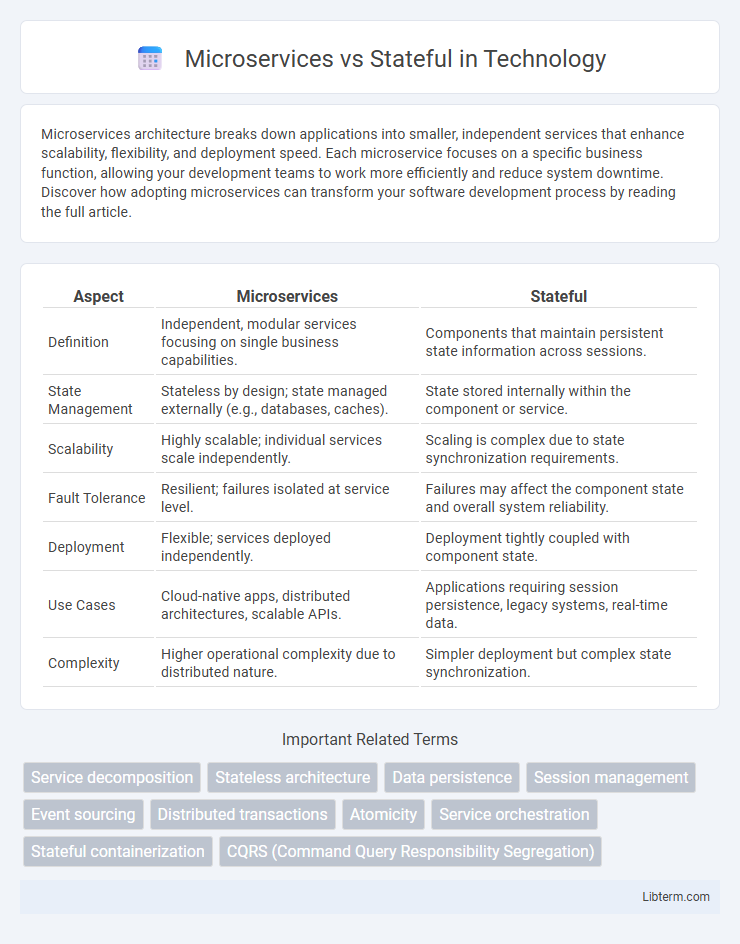Microservices architecture breaks down applications into smaller, independent services that enhance scalability, flexibility, and deployment speed. Each microservice focuses on a specific business function, allowing your development teams to work more efficiently and reduce system downtime. Discover how adopting microservices can transform your software development process by reading the full article.
Table of Comparison
| Aspect | Microservices | Stateful |
|---|---|---|
| Definition | Independent, modular services focusing on single business capabilities. | Components that maintain persistent state information across sessions. |
| State Management | Stateless by design; state managed externally (e.g., databases, caches). | State stored internally within the component or service. |
| Scalability | Highly scalable; individual services scale independently. | Scaling is complex due to state synchronization requirements. |
| Fault Tolerance | Resilient; failures isolated at service level. | Failures may affect the component state and overall system reliability. |
| Deployment | Flexible; services deployed independently. | Deployment tightly coupled with component state. |
| Use Cases | Cloud-native apps, distributed architectures, scalable APIs. | Applications requiring session persistence, legacy systems, real-time data. |
| Complexity | Higher operational complexity due to distributed nature. | Simpler deployment but complex state synchronization. |
Understanding Microservices Architecture
Microservices architecture decomposes applications into loosely coupled, independently deployable services that focus on specific business functions, optimizing scalability and maintainability. Unlike stateful applications that retain session information within a single instance, microservices are designed to be stateless, storing state externally to enhance resilience and load balancing. This statelessness enables microservices to handle large-scale, distributed systems more efficiently, supporting continuous integration and deployment pipelines.
What Does "Stateful" Mean in Software Systems?
Stateful software systems maintain information about user sessions or transactions across multiple interactions, enabling continuity and context retention. In contrast to microservices, which often emphasize statelessness for scalability, stateful architectures store data locally or in persistent storage to manage complex workflows. Understanding statefulness is crucial for designing systems that require session management, real-time data processing, or transaction integrity.
Key Differences Between Microservices and Stateful Approaches
Microservices architecture decomposes applications into loosely coupled services, enabling independent deployment and scalability, while stateful approaches maintain persistent state within a single system or service. Microservices emphasize statelessness to enhance fault tolerance and facilitate horizontal scaling, whereas stateful designs rely on in-memory or database-stored session data, which complicates load balancing and recovery. The key differences lie in scalability, fault isolation, and state management, with microservices offering greater flexibility and resilience in distributed environments.
Benefits of Microservices in Modern Development
Microservices architecture enhances scalability by allowing independent deployment and management of services, reducing downtime and improving fault isolation. It promotes flexibility through technology diversity and simplifies maintenance by breaking applications into smaller, manageable units. This approach accelerates development cycles and enhances resilience, meeting the demands of modern, dynamic software environments.
Challenges of Managing State in Distributed Systems
Managing state in distributed systems presents significant challenges due to data consistency, synchronization, and fault tolerance complexities. Microservices architecture often relies on stateless services to simplify scalability and resilience, but maintaining state across distributed instances requires techniques like event sourcing or distributed caches. Stateful systems must handle partition tolerance and network latency while ensuring data integrity, making state management a critical concern in microservices deployments.
Stateless vs. Stateful: Which Suits Your Application?
Stateless microservices handle requests independently without storing session data, enabling seamless scalability and fault tolerance for applications requiring high availability. Stateful services maintain client state across sessions, making them ideal for applications like online banking or gaming where continuous user context and data consistency are critical. Choosing between stateless and stateful depends on application needs for scalability, session persistence, and data integrity.
Common Use Cases for Microservices
Microservices architecture excels in building scalable, modular applications where independent deployment and development of services are crucial, such as e-commerce platforms, real-time data processing, and cloud-based applications. It supports stateless design principles, enabling flexibility and reliability across distributed systems, making it ideal for microservices that manage user authentication, inventory management, and payment processing. Stateful applications, by contrast, maintain session information and are better suited for use cases like online gaming or shopping carts where persistent state is necessary.
When to Choose Stateful Architectures
Stateful architectures are ideal when applications require persistent data storage and continuous sessions, such as in financial transactions, gaming, or user-specific workflows. They handle complex state management efficiently by maintaining context across requests, which is crucial for applications needing real-time data synchronization or long-lived interactions. Choose stateful designs when consistent data integrity and session continuity outweigh scalability concerns inherent in stateless microservices.
Scaling Considerations: Microservices vs. Stateful Systems
Microservices architecture offers superior scalability by enabling independent deployment and scaling of individual services, allowing resources to be allocated precisely where needed. Stateful systems maintain session information, which complicates horizontal scaling because data synchronization and consistency must be managed across instances. The stateless nature of microservices reduces the overhead of state management, enhancing elasticity and resilience under varying load conditions.
Best Practices for Integrating Microservices and Stateful Components
Best practices for integrating microservices and stateful components involve decoupling state management from business logic using techniques like event sourcing and distributed caches. Leveraging API gateways and service meshes ensures secure, reliable communication between stateless microservices and stateful databases or message queues. Implementing consistent data replication and eventual consistency models optimizes performance while maintaining data integrity across microservice architectures with stateful dependencies.
Microservices Infographic

 libterm.com
libterm.com